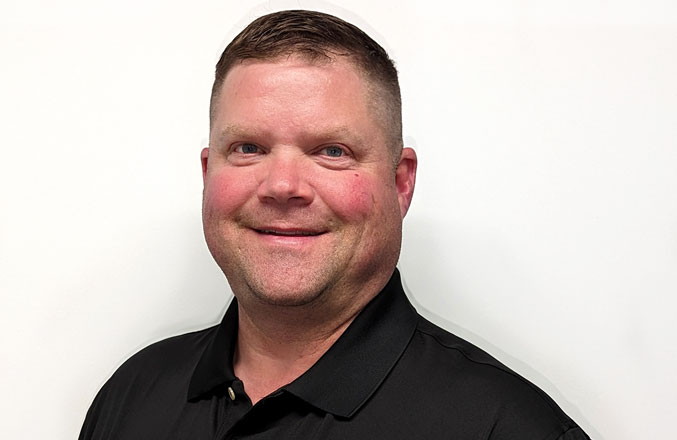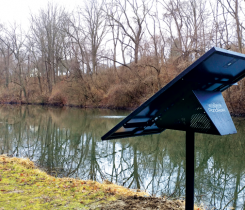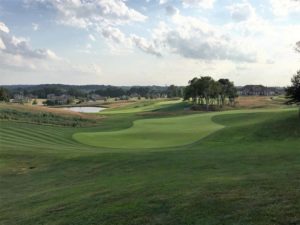When Toro was a fertilizer company — the forgotten tale of BioPro
If you tried to explain to millennial superintendents the BioPro Phenomenon — whereby iron and irrigation giant Toro briefly went into the fertilizer business during the 1990s — they might not believe you.
But should you engage a slightly older cohort of supers — those who plied their trade during the second Clinton Administration — they won’t just remember the BioPro brand; they will be likely to recognize the unique line of products as having pioneered a range of foliars, micronutrients and seaweed extracts that, judging from their ubiquity in the market today, were way ahead of their time.
“They came in green and white jugs, not red,” recalls Matt Taylor, head superintendent at Royal Poinciana Golf Club in Naples, Fla. “It was a great product line. They were very clean products, even by today’s standards. When you finished with the jug, there was never a bunch of sludge in the bottom.”
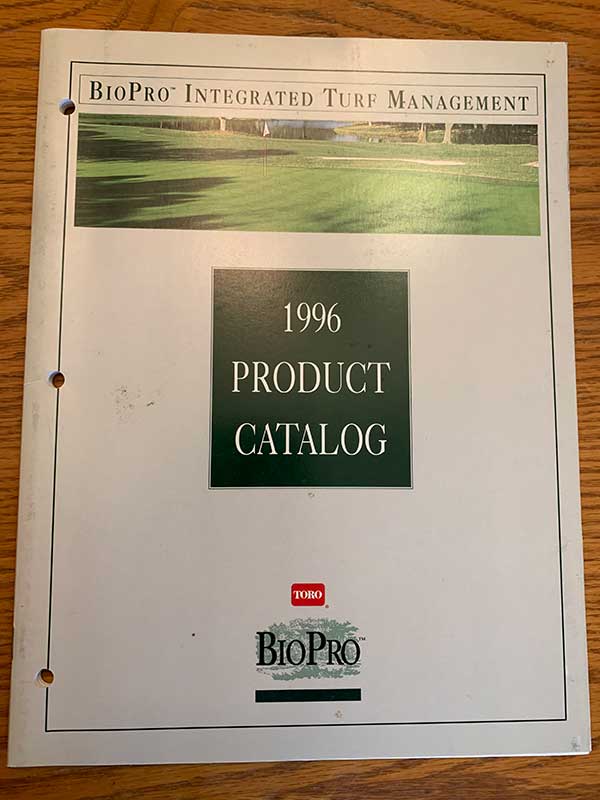
Photo: Hal Phillips
“I tell you what: The BioPro products were very consistent. I remember that,” says Kenyon Kyle, superintendent of Audubon Country Club in Louisville, Ky. “I guarantee you I still have notes on all that stuff, all the particular application rates. My recollection was, when Toro got rid of BioPro, it was just gone. No conversation. They just washed their hands of it. It was just gone — like the Cleveland Browns in the middle of the night.”
Filling the vacuum
Toro did, in fact, decide rather abruptly to vacate the fertilizer business. But the BioPro product line didn’t vanish into thin air. More than 20 products that remain on the market today still boast the BioPro pedigree. In fact, each of them is readily available today and well supported by Ecologel Solutions.
Jim Spindler is the key link in what has been a long, circuitous chain. He worked under Max Brown, Ph.D., at Liquid Ag, which Toro purchased in advance of the BioPro venture. He represented the BioPro line as part of Toro’s late ’90s sales force, then followed the products to Terra Biotics when Toro opted out. When Terra Biotics was going out of business, he rescued the product lines in exchange for a hunk of back pay. Spindler would partner in 2008 with Rick Irwin when Ecologel Solutions acquired the former BioPro Line.
Just last year, Ecologel partnered with the tree specialists at Arborjet to create a full service plant-health partnership that, for the first time in 20 years, has put some marketing muscle behind these category-creating formulations.
“Arborjet is putting some real marketing horsepower behind us, which is something we’ve often missed,” Spindler says. “We’ve been a small player for a while now, with no budgets for advertising or social media. Arborjet is putting feet on the ground, too. They just hired three more regional sales managers to sell our products around the country. It will make us far more visible.
“We tend to have the same two conversations about the BioPro line. Millennial supers have never heard of these products; they don’t recognize the phrase ‘BioPro’ at all. But the older guys are like, ‘That stuff is still around? I love that stuff.’ We are determined to get it back into the limelight again because their efficacy has never diminished. And supers who knew them way back when will quickly notice the new, effective combinations we’ve created with our moisture manager, Hydretain, and our seaweed product, CytoGro. We’re addressing new issues like salts, bicarbonates and thatch accumulation. This is a modern product line that has kept up with the times.”
Without Spindler, the Bio Pro line might well have been lost to history. Which makes him something of a missing link — one who, luckily — never went physically missing.
“These products have survived so long because they work, but yes, it has been a long and winding road,” Spindler says with a rueful chuckle. “The industry has evolved a great deal, but in this respect, it has evolved in directions that led right back to what we were doing with these products 20 years ago.”
Back in the day
Before Toro commercially launched the BioPro venture, it gathered a group of innovative, environmentally inclined superintendents from across the country to test-run the products and process. Dan Dinelli at North Shore Country Club in Glenview, Ill., — today the dean of environmentally astute turf managers in the Midwest — was one of those supers.
“That was several computers ago; it’s a bit painful to go back there,” says Dinelli, clearly caught off guard by the topic but gathering steam as the conversation continues. “But so many parts of that program are a big buzz today. The probiotics and seaweed. It’s almost hard to find a fertilizer today that doesn’t have humic acid. Back then you had N, P, K — maybe you had a chelating agent, a biostimulant. But now it’s common to find a fertilizer with coating humic or seaweed extract, or both.
“It plays into a lot of things we’re doing right now. But back then, sensors were just coming in as a potential tool, and that was Toro’s vision, as I recall — to develop an in-house full-circle program, sensor-driven, based around specific soil needs and soil management.”
Not every superintendent would have near infrared-testing capability; that wasn’t Toro’s plan. The idea was that each Toro distributor would have a near-infrared testing unit on hand, plus an agronomist to help client supers conduct this analysis. Folks would arrive with soil and tissue samples; they would go home to their courses with results and jugs of the appropriate fertilizer products custom-prescribed to their courses.
“That was the original idea: to use soil analysis and near-infrared spectrometry to analyze the soil and turf/leaf tissue, then develop a prescription for each one based on those results,” Spindler explains. “It was completely out-of-the-box thinking for that time.”
Toro devoted a huge amount of time, effort and star power to the BioPro project. Legendary agronomist Jim Watson, Ph.D., participated in its development; Van Cline did much of his Ph.D. research work on the BioPro line, Spindler says. But one cannot separate the BioPro phenomenon from Max Brown, Ph.D.
“Many of our Ecologel products today, the combinations especially, have a lineage back to Dr. Brown,” Spindler says, citing a number of examples. “Iron Plus (originally Turf Iron), Turf Starter, Calcium Plus (originally called w/ Calcium), Magnesium Plus (originally called Magnesium), Manganese Plus (originally called Manganese and Silica) are all products that appeared in the 1994 Toro BioPro Catalog. Bio MP (with molasses), TurfPlex 20-2-3, Tuff Greens 0-0-13 actually go back to a company called Bio Humanetics, which had manufactured the products for Toro.
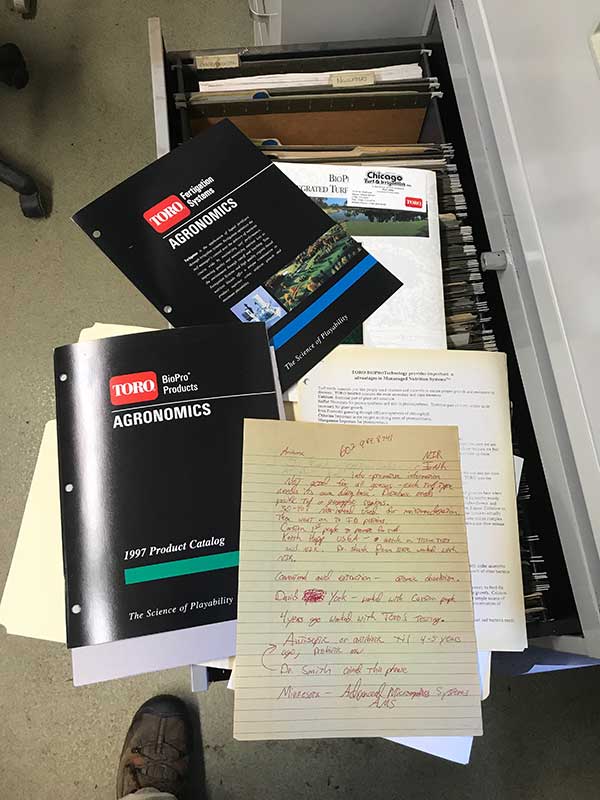
Photo: Hal Phillips
“The 1997 Toro BioPro catalog changed the names to our current names and added Greens Plus 14-4-10, Greens Plus 12-0-12, Enviro N, Enviro P, Enviro K, Nutrisolve, Spectrum, Boron and NaX (formerly called Exsodis).”
This clear attempt to dial in the exact needs of site-specific soil and plant tissue was the reason so many ’90s-era superintendents were so enthusiastic about BioPro. The ability to mix and match the attributes of foliar products was exhilarating.
It was also the reason they took so many notes.
“Max was really the guy who developed much of the BioPro line,” Aububon’s Kyle recalls. “He was the scientist who met with us once a month when we were demoing these products. Matt [Taylor] and I both worked at that time at Bonita Bay for a gentleman named Mark Black. He really led the charge with BioPro. We were a beta site, I guess.
“Max was very intelligent with plant nutrition, but we’d throw seven different products in the tank — that’s why we paid so much attention to applications rates and took so many notes. Max and Mark Black would want to do that one week, then tweak the nitrogen and iron the next week. It was very technical, with all these component parts. But I tell you what, it was so very consistent, the BioPro was.”
That was the other reason for all the note taking: What worked before would work again, provided you took duplicated rates and mixtures.
“The idea,” Spindler says, “was to have slow-release organic-based fertilizers that supported the soil microbial activity — and then the liquids would take care of the rest of the fine tuning.”
According to Matt Taylor, “It seemed very cutting edge at the time, and it was. There were a lot of bagged fertilizers that we could mix 20-20-20 — that we could solubilize. But all of a sudden, these packaged products were on the scene. What I really remember was a dry line of granular and one product — I can’t remember what the analysis was; it had some organics in there — but we loved it. It smelled like pine tree sap! Everyone I come across, I keep asking them about this one line. I remember that smell…
“But generally, it just made sense. Everyone’s got different soils and conditions. It may be the same turf from course to course, but managing that turf is so site specific: My soil here is totally different from Pelican Bay, which is only 5 miles away. It all depends on where they got their fill, where I got my fill, who has more of this tree or that tree. Maybe my water quality does something to it …”
Though the Toro line never specifically promoted disease or insect suppression, Spindler says, BioPro did play an important role in this management evolution — even if the roots of this movement have been obscured by the passage of time.
“We are programmed as superintendents to be disease driven, and when you talk about diseases, we’re used to using the word control,” Dinelli says. “If you put chemical A down at X per thousand, you get at seven- to 100-day window of control. If you do it properly, you rarely get a failure. With an approach like this, it’s really more about suppression and delay and the extent of disease. Take dollar spot. If I put a biological down to suppress onset for a few days, that might be enough to mean not putting a chemical down. Or, instead of an unacceptable 20 percent expression of symptom, you put something down biological and get 5 percent or 7 percent expression — and maybe that’s acceptable.
“We were really connecting the dots on all this back then. The sales documents for the BioPro — I have them all here in a folder, along with all my notes — if you were to read them today, they’d be very fitting for what is mainstream methodology today: the humics, the enzymes and how important they are, how these inputs collectively come together to achieve disease suppression.”
Losing the battle, winning the war
In many ways, Toro and BioPro lost the commercial battle. “What happened was, Toro only allowed sales through Toro distributors,” Spindler explains, but the foliar phenomenon and the suppression approach eventually won the war. One look today at the range of products in this category tells you that much.
One reason foliars eventually would become so popular and trusted was the emergence of Grigg Bros. Fertilizers, another company that owes a debt to BioPro. Back in the early 1990s, Mark Grigg had been selling a line of probiotic foliar products into the ag industry out west. Among the products was an environmentally friendly liquid nutrient product developed by Liquid Ag. Eventually, that product was purchased and relaunched under the BioPro banner. When Toro divested in BioPro, Grigg lost the product line but gained an insight into what this type product could do.
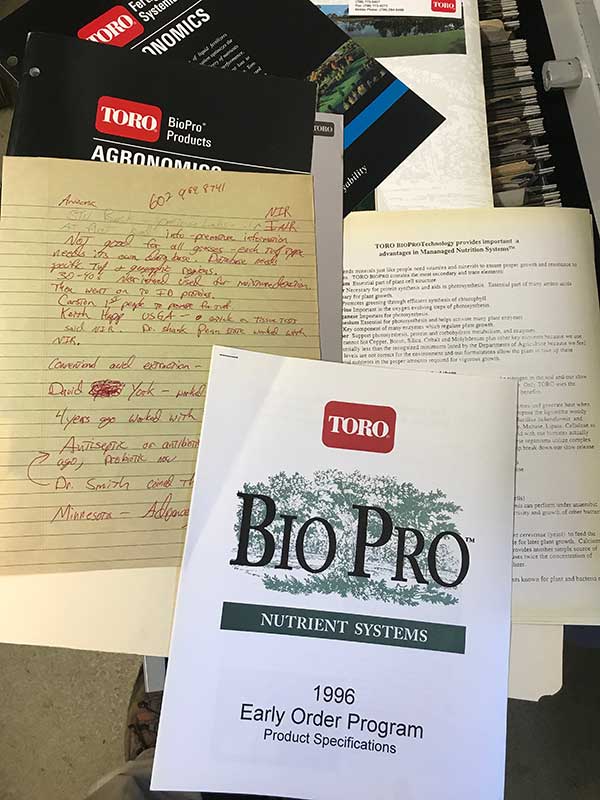
Photo: Hal Phillips
Soon thereafter, Mark met Gene Miller, Ph.D., a plant biochemist from Utah State University who had developed a liquid foliar technology for the ag industry. Mark shipped some test product to his brother Gary, then a superintendent in Florida. Gary was blown away by its effectiveness on turf. The brothers went back to Miller, licensed the product for turf, and thus the “Gary’s Green” product (and Grigg Bros. Fertilizers) were born.
Even then, the great majority of superintendents during the 1990s simply weren’t far enough along on the evolutionary curve to realize what these products could do. “At 4 percent, you get nitrogen suppression, but at 5 percent, you get a pretty juiced up plant,” Dinelli says.
“The concept was, with Toro irrigation and fertigation capability and access to percent nitrogen content and microbial in the fertilizers, you could develop a disease-suppressive program without using pesticides,” Dinelli adds. “But if you were chemical oriented, you were always disappointed because we were not at the stage where you could control disease with suppression. Back in the ’90s, they were trying to get us thinking about this suppression thing — all together, under one umbrella, and we probably weren’t ready to think about things that way back then.”
Taylor sees a specific way that foliars in particular were mainstreamed in Florida. Ironically, this application took root about the same time Toro divested in the BioPro line. The reason? In a word, Primo.
“Primo had just started coming out then, too, and this is how we used it: We used to add the micronutrients to mask the effect of the Primo, the bronzing,” Taylor says. “It was a byproduct. We figured, ‘We spray Primo; we may as well use this other stuff at the same time.’
“Then ultradwarf came out and we sprayed a bunch more PGR, and so we would add micronutrients to mask that effect. Now you’re using micronutrients, playing around with them a lot more. You’ve got to put Primo down, so maybe you’re adding BioPro type stuff: nitrogen, potassium, silica, maybe some manganese. Low in Boron? Boost it. The BioPro fostered that type prescriptive approach.
“In early 2000s, we all started switching over to the ultradwarfs and guys started seeing they couldn’t use the same nitrogen. We really sort of took on a bentgrass mentality, meaning low use rates. For me, that’s when the whole thing kind of changed. It used to be, ‘Hey, I’m using liquid fertilizer; let’s throw in some Primo.’ Then it became, ‘I’m using Primo, let’s throw in some liquid fertilizer.’”
The most specific BioPro legacy is found throughout the Ecologel product line. But the broader legacy is everywhere. As Taylor points out, “Everyone’s got their own liquid fertilizer now. SiteOne, Harrell’s, Howards. Everyone’s got their own product line. It’s actually gotten extremely confusing, in my opinion. They all do much the same thing — and they’ve gotten astronomically expensive. It’s a mature market now, in the business parlance.”
Spindler is partial, understandably, to the results superintendents can achieve using BioPro’s direct descendants in the Ecologel line. For the rest of us, it’s akin to the dilemma we encounter while standing in front of the beverage cooler at a convenience store. There are so many cola options today … but sometimes you just want a Coke.









